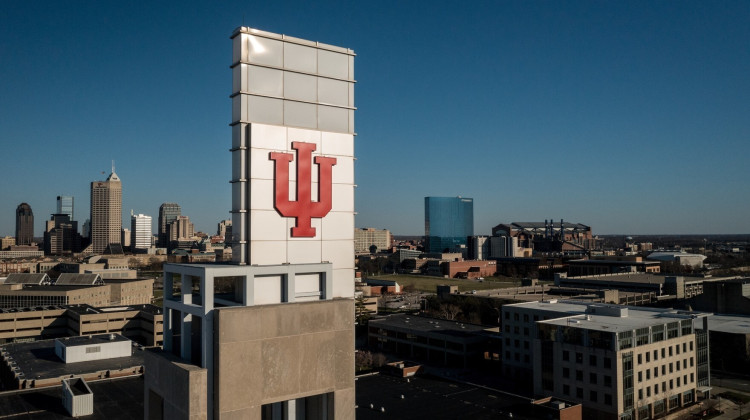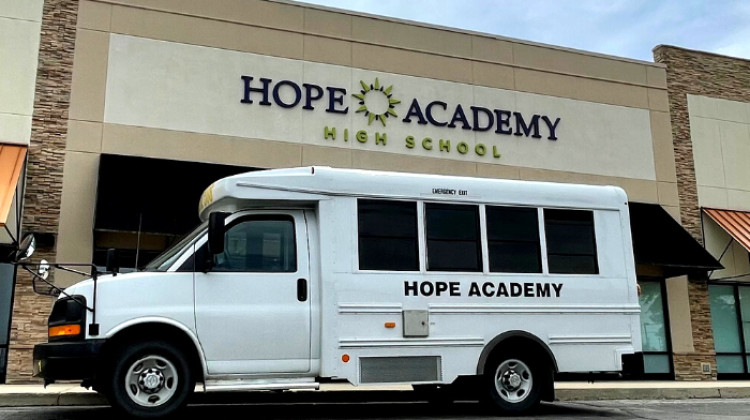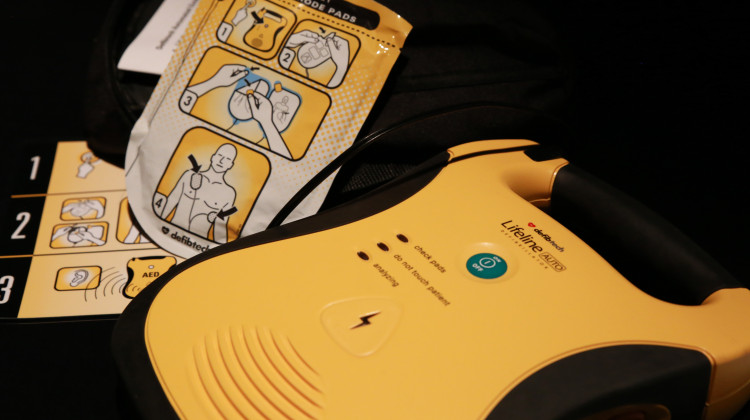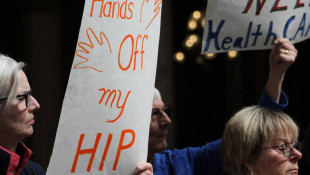
Chicago high schoolers Elayja Stewart (far left), Shekinah Jackson (second from right) and Dasia Madden (far right) with their counselor Nora-Lisa Malloy (second from left) outside the Illinois State Capitol on a field trip with the school-based mental health program Working on Womanhood. (Photo courtesy of Youth Guidance)
If you or someone you know is in crisis, please call, text or chat with the Suicide and Crisis Lifeline at 988, or contact the Crisis Text Line by texting TALK to 741741.
Shekinah Jackson walked into her first day at Chicago Vocational High School on the city’s South Side convinced she’d spend the next four years alone.
She’d been bullied for years about her weight, her skin complexion and the way she talked. In seventh grade, a classmate called her stupid in science after she asked a question. After that, she stopped speaking up in class.
By her freshman year in 2019, Jackson had come to believe the taunts. She tried to disappear at school — kept her head down, sat in the back, wore hoodies.
“I truly felt like I would never be good enough for anyone,” Jackson recalled in an interview last month.
While Jackson may have felt alone, she’s part of what experts are calling a crisis in the mental health of girls.
A recent report from the Centers for Disease Control and Prevention found that in 2021, almost 60% of high school girls in the U.S. felt persistent feelings of sadness or hopelessness, nearly 20% had experienced sexual violence, and 25% had made a suicide plan. Clinicians, educators and policymakers around the country are racing for solutions. A recent study suggests that a Chicago-based program could be a model to help girls throughout the U.S. — especially girls of color — cope with the trauma and distress many face.
Working on Womanhood
The education nonprofit Youth Guidance launched the program Working on Womanhood – or WOW – in 11 Chicago public high schools in 2011. The school-based counseling and mentoring program was developed by Black and Latina women to help girls in their community who experienced high levels of trauma but received little mental health support.
Over the last decade Ngozi Harris, WOW's director of program and staff development, has worked with hundreds of girls who have seen loved ones die in front of their eyes, been raped or had to deal with hunger and homelessness. A large body of research shows those kinds of childhood trauma often lead to depression, addiction and suicide. But Harris said mental health resources are often funneled to boys, whose symptoms tend to stand out more.
“The narrative for girls is they don't need help because they're getting straight A's. Our boys, on the other hand, are acting out a lot, and they need more support,” Harris said. “For us, it is about making sure that everybody understands that just because she's able to sit quietly doesn't mean that she's not going through something and needs support.”
WOW counselors meet with small groups of girls weekly during the school year, relying on techniques like cognitive behavioral therapy to help the girls develop healthy coping skills and take more control of their lives.
The program clicked for Shekinah Jackson in her freshman year. Her counselor, Nora-Lisa Malloy, passed out mirrors to Jackson and the other six girls in the group and asked them to describe what they saw.
“‘I am ugly. I'm not good enough. People call me loud. People call me fat. I'm too skinny,’” Malloy remembers the girls sharing. “They saw all these imperfections that are in their head.”
For the first time, she realized other girls felt just like her.
“It felt like weights being lifted off my shoulders,” Jackson said. “It just felt good that I wasn't holding it in anymore. And that I can come and talk to someone about this, and that I'm just not dealing with it all on my own. It made me want to ask for help more.”
The very next week, Jackson needed help on a biology lesson. She had avoided asking teachers anything since that boy called her out in 7th grade. With the gaze of her classmates on her back, Jackson walked from the back of the class to the teacher's desk.
“It was just me in the back of my head saying, ‘OK, you got this. Nobody's going to say anything. It's OK. You can go up there and ask for help,’” she said.
And that was when Jackson broke out of her shell, Malloy said.
“Her head was held high. She's walking down the hallway with so much confidence – she's not worrying about what people are saying, what they're doing,” she said.
Girls like Jackson have thrived since WOW's inception. But Harris understood that for the program to become a national model to help girls of color cope with their trauma, the organization needed more than anecdotes.
“We wanted to not only be able to say we are successful in this and we're seeing impact in this,” Harris said. “We wanted the data to show it as well.”
Evaluating WOW’s impact
There has been relatively little research on the mental health of Black and Latina girls in the U.S.
In 2017, researchers Monica Bhatt, Jonathan Guryan and Harold Pollack at the University of Chicago’s Education Lab led a survey of girls across 10 city high schools and found many regularly witnessed physical assaults and the sudden ––sometimes violent –– death of a loved one. More than one-third reported symptoms of post-traumatic stress disorder, such as having persistent negative thoughts or constantly being on guard — twice the rate of PTSD symptoms seen among returning Iraq and Afghanistan war veterans.
“Candidly, when I started seeing those numbers come in, I thought there was something wrong in our measurement,” said lead researcher Monica Bhatt. “I thought we were doing the analysis wrong.”
Next, Bhatt and her team ran a study that randomly selected 1,232 high school girls to receive WOW counseling and mentoring to test the program’s impact. The study’s main goal was to see if the program improved girls’ mental health — specifically anxiety, depression and PTSD — as well as grades and school attendance.
The researchers saw no significant drop in clinical mental health diagnoses compared to girls not enrolled in WOW, but they did see significant decreases in symptoms of anxiety (10%), depression (14%) and PTSD (22%).
Sheretta Butler-Barnes, a developmental psychologist at Washington University who is not unaffiliated with the study, said WOW is one of the first one of the first school-based mental health programs designed for girls of color to show such positive results in a rigorous evaluation.
“This program is needed,” said Butler-Barnes who studies the mental health and academic achievement of Black girls. “And it's needed in a lot of spaces because of what girls are going through, particularly girls of color.”
But the study found WOW had no impact on the girls’ grades or attendance. Lead researcher Bhatt said that makes sense, since most of the girls went into the program with strong attendance and at least a B average, and WOW’s focus is on improving mental health, not grades.
She said the findings challenge the notion that academic improvement should be a key element of any school-based mental health program.
“We're forced to reckon with whether this is important — to mitigate these harms for girls who are showing up and doing what society expects them to but are carrying a really big load,” she said.
Attention and funding are growing
The study’s findings, published in the journal Science Advances in June, come at a moment when experts say policymakers have zeroed in on girls’ mental health.
Republican and Democratically-controlled states have poured at least $8.5 billion of federal funding into school mental health since 2021, with many states chipping in additional funding from their own coffers. Federal officials have also made it easier for Medicaid to pay for school-based mental health services.
There is evidence-based programming that has been shown to work, said Kathleen Ethier, the director of the CDC’s Division of Adolescent and School Health. Proven strategies include connecting kids to counselors and educating young people about mental health.
Research shows that kids who feel connected to the adults in their school are less likely to report poor mental health, illegal drug use, suicidal ideation and sexual violence.
“All of this is around increasing the sense of connectedness,” Ethier said, “so that young people are less likely to engage in violence, perpetuate violence and experience trauma. Or, if something happens to them, they have an adult right there.”
WOW’s ability to reduce PTSD symptoms is particularly promising, Ethier said, adding that she hopes more schools implement this sort of evidence-based intervention.
Significant barriers remain
One in five schools had unfilled jobs for mental health workers as of last September, and few districts meet the recommended ratios of student to school psychologist or school counselor. While state and federal lawmakers have invested in hiring and training more mental health providers and some schools have turned to telehealth, experts predict it will take years for the workforce to grow enough to meet the demand.
The larger political battle over what parents think should be taught to their kids in schools can also slow adoption. Heidi Sipe, the superintendent of the predominantly Hispanic Umatilla School District in northern Oregon, said some parents also worry about their kids being taken away if they use mental health services at school.
“I do respect the role of a parent,” Sipe said. “But if we're not providing a wide variety of services, and if we're not attempting to have that dialogue with the naysayers, then we're failing students.”
When they are able to have a conversation, Sipe said, parents usually come around. But she has colleagues around the country who have lost that fight, and have struggled to add new mental health services.
Researchers like Butler-Barnes at Washington University also say it’s important to make sure the interventions schools invest in are good cultural fits for the students they’re trying to help.
Butler-Barnes said more general programs often leave out the experiences of people of color, so if schools want to help Black and Latina girls, they should look for programs designed specifically for them that include talking about the role of racism and sexism in the girls’ lives, incorporating familiar cultural and family values, and focusing on empowerment in addition to treatment.
WOW looks ahead with confidence
From just 11 schools in Chicago in 2011, WOW is running in 89 schools across Illinois, Kansas City, Boston and Dallas, serving more than 4,000 girls. Ngozi Harris said since the study was published, more school districts have reached out.
Shekinah Jackson said the skills she learned in WOW helped her navigate problems throughout her time in high school – from getting her grades up by the end of senior year to walking away from a toxic relationship.
“I learned that it's OK to reach out and ask for help,” she said. ”And it's OK to not be OK sometimes. It's OK to cry. But I don't have to sit there and suffer.”
She said WOW also gave her the confidence to expand her horizons and travel 180 miles from home to start her freshman year at Eastern Illinois University, where she hopes to study psychology.
“Honestly, right now I'm not scared of anything,” Jackson said. “I feel like I can overcome anything that's being thrown at me.”
At 14, Jackson was confident she would never be good enough. At 18, Jackson is just confident.
This story comes from the health policy podcast Tradeoffs, a partner of Side Effects Public Media. Dan Gorenstein is Tradeoffs' executive editor, and Ryan Levi is a producer for the show, which ran a version of this story on September 14. The study on Working on Womanhood was funded in part by Arnold Ventures, which also supports Tradeoffs.
Side Effects Public Media is a health reporting collaboration based at WFYI in Indianapolis. We partner with NPR stations across the Midwest and surrounding areas — including KBIA and KCUR in Missouri, Iowa Public Radio, Ideastream in Ohio and WFPL in Kentucky.
9(MDAyMzk1MzA4MDE2MjY3OTY1MjM5ZDJjYQ000))
 DONATE
DONATE





 View More Articles
View More Articles


 Support WFYI. We can't do it without you.
Support WFYI. We can't do it without you.